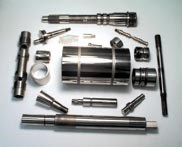Bolt-On Microfinishing
The process of microfinishing or superfinishing, as it's also known, is finding wider application in metalworking. Demands for better performance in rotating components coupled with tighter manufacturing tolerances is leading shops to look at microfinishing as a final process step to achieve low and sub-micron finishes on ground parts.
Share




The process of microfinishing or superfinishing, as it’s also known, is finding wider application in metalworking. Demands for better performance in rotating components coupled with tighter manufacturing tolerances is leading shops to look at microfinishing as a final process step to achieve low and sub-micron finishes on ground parts.
Columbia Tool & Die Company (Clinton Township, Michigan) has developed a retrofitted microfinishing attachment for shops looking to add microfinishing capability to their process mix. The device Columbia has developed is designed for installation on an obsolete lathe or grinder that a shop may have on hand.
Microfinishing uses an abrasive. In some cases, Columbia will install a continuous feed tape to stabilize the microstructure of the workpiece surface after it has been ground. Grinding, even with fine abrasive grit, leaves what are essentially machining marks on the surface of the workpiece.
These marks take the form of peaks and valleys that are very small and generally require a microscope to see. However, they can affect how well the part performs.
Microfinishing removes the peaks on the workpiece leaving a more stable micro surface. Different abrasive patterns, grits and oscillation rates enable the shop to impart cross hatch patterns for lubrication retention and other patterns, as specifications require. Workpieces including transmission shafts, axles, bearing races and other wear applications will usually see an extended life cycle from the use of microfinishing.
Many companies would prefer to try out a new process, such as microfinishing, before committing to investing in new equipment. Columbia will install a microfinishing unit for use on older lathes and grinders that shops may have on the floor but are not using for manufacturing. The idea, says the company, is to give shops exploring microfinishing an alternative to purchasing a new stand-alone machine.
Columbia's installation of a microfinishing unit combines both cylindrical geometry and surface improvement in a single machine. These attachments are more than “polishers” in that they use high performance microfinishing tape in conjunction with roller type tooling to create specific surface finishes, surface lay (cross hatch/circumferential patterns) and improved circular geometry.
In operation, the workpiece is mounted in the lathe or grinder chuck between centers as needed. The part is rotated at relatively slow speed. The tape unit, mounted on the lathe turret or grinder wheel head, is fed to the work. A contact roller applies the tape to the part while oscillating at lower amplitudes and higher frequencies. Electronics, included in the attachment, control the oscillation, cycle time and tape feed rates.
For shops looking to add microfinishing capability economically, this unit may be a good way to explore a new process technology. MMS






















.png;maxWidth=300;quality=90)





